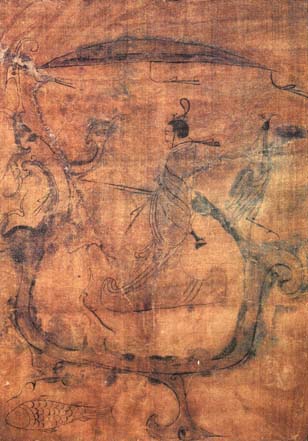
From its emergence to maturity, Chinese painting stretches over a long period that dates back to the remote Neolithic Age (8,000-5,500BC). The working early human produced practical utensils and structures with decorative designs that engendered the earliest consciousness about painting composition.

As a wall ornament, the silk painting, which contains characters of early Chinese painting, emerged in the Warring States Period (403-221BC). Representatives of such works includeLady, Dragon and Phoenix Painting and Man Driving the Dragon, which were unearthed in Changsha City, Hunan Province. Both pieces were used at funerals to lead the dead to heaven. The Lady, Dragon and Phoenix Painting depicted stories of the deceased in the tomb. The matching of colors -- black and white, the contrast of false and truth, movement and stillness -- are striking. The Man Driving the Dragon depicts a bearded man wearing in a robe with a dragon beside him and a white bird standing on his tail, which demonstrates the noble status of the deceased. Among the remaining paintings are the excellent representative works of the Han Dynasty, when elaborate funerals were popular, like the one unearthed in the Mawangdui Han Dynasty tomb in Changsha City. The silk painting contains three parts: the Heaven, World and Hell. The Heaven is a horizontal scroll, while the others are vertical, wishing the deceased spirit entered Heaven.
The discovery of the silk paintings provided important historical materials for researching the development of traditional painting.










